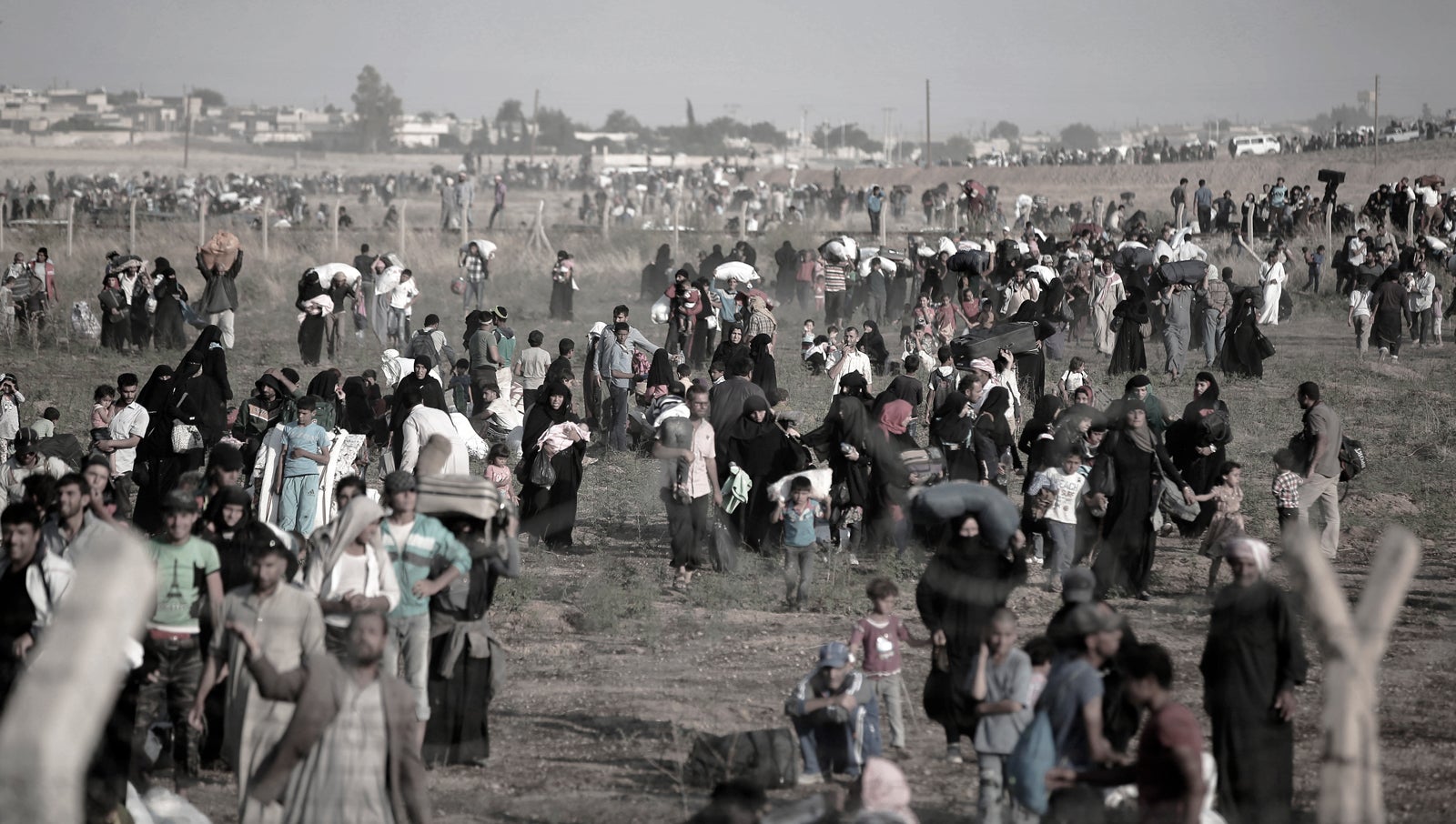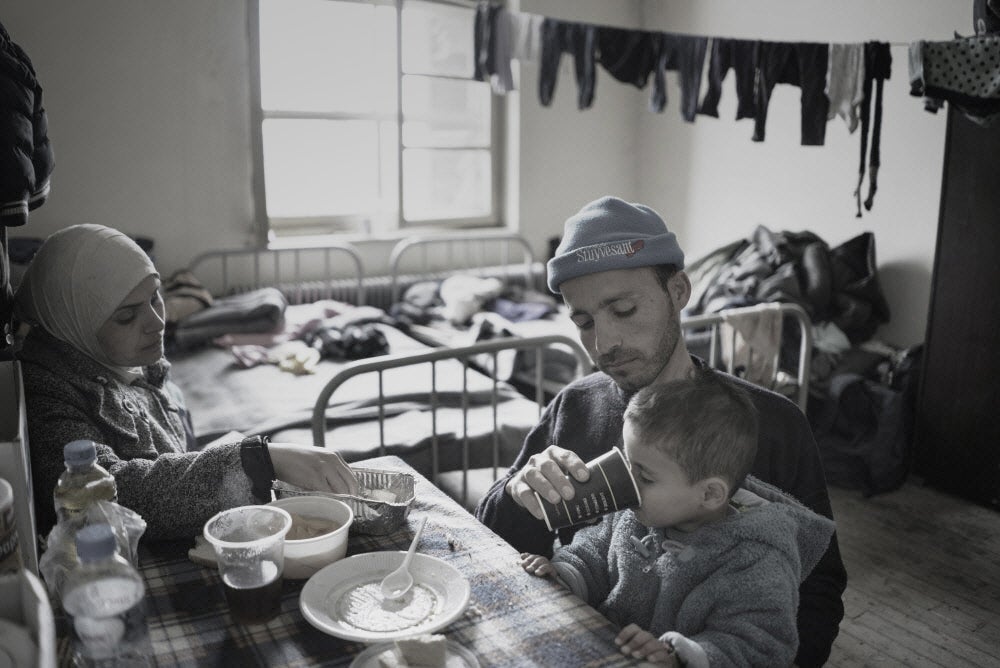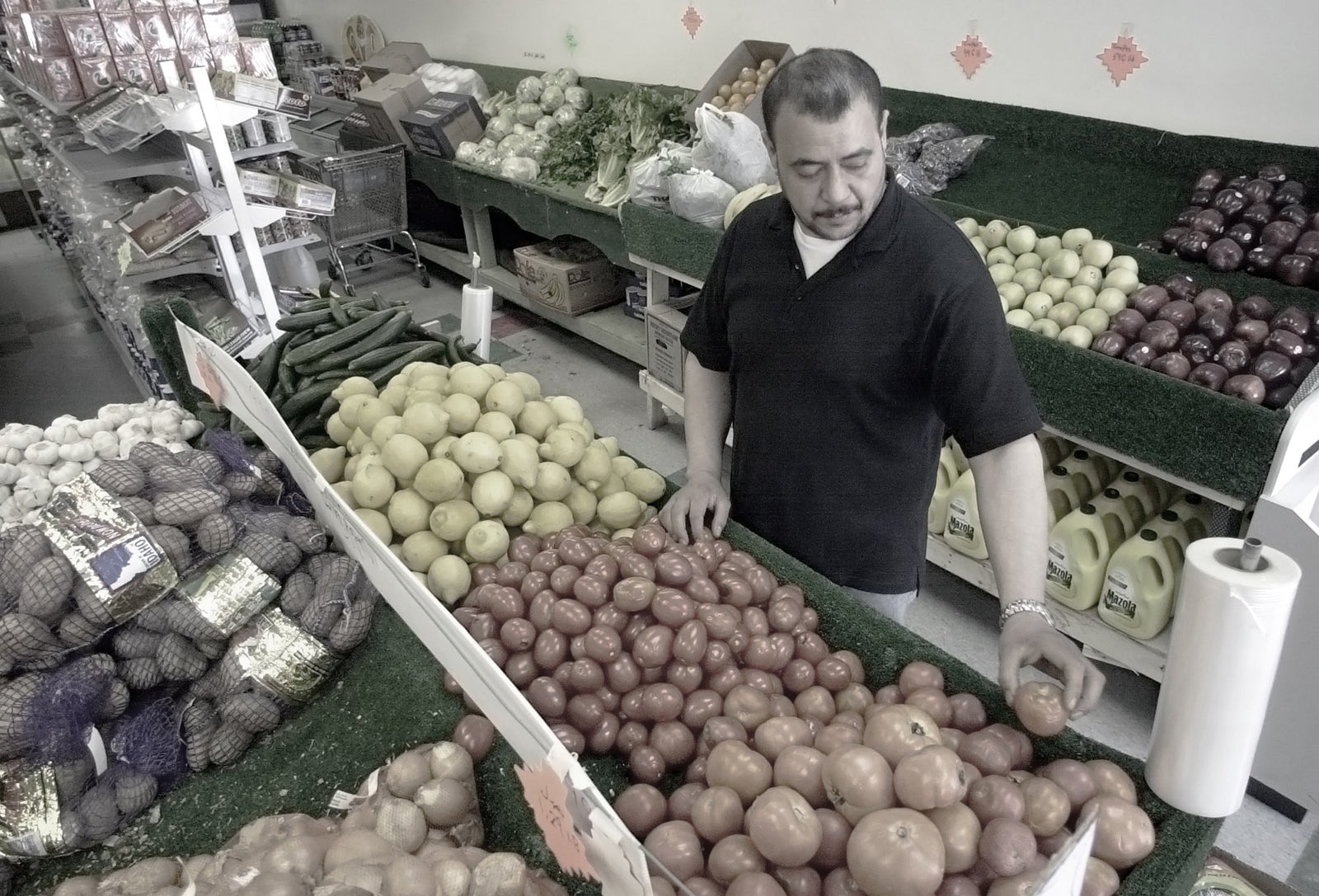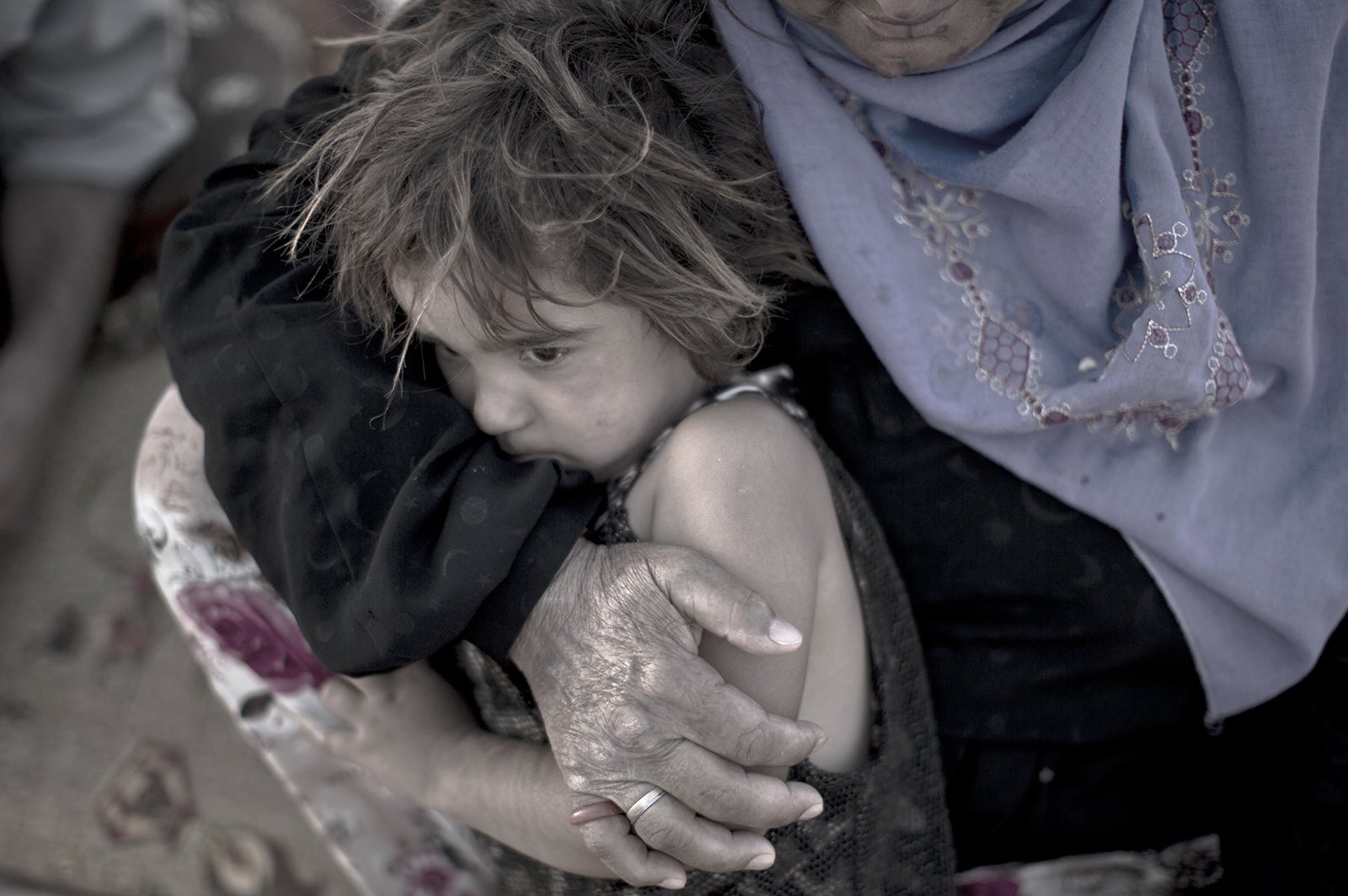Migration
1CHANGE THE NARRATIVE.
Talk about migrants and refugees not as an undifferentiated mass of strangers but as individuals—and treat them as individuals, each with her or his own singular history of displacement and suffering.
MICHAEL VANROOYEN: We work in public health—we’re numbers people. But ultimately there needs to be a face for refugees that gets permeated throughout the media, so that the United States and Europe and other countries dealing with this issue see it in terms of people: individuals, families, and kids who are seeking a better life after enduring terrible circumstances.
JENNIFER LEANING: The danger of hate speech is quite high now in the United States, as it is in other parts of the world. And the press echoes, reverberates, and gives great credence to vitriolic speech. My hope is that humane U.S. state governors will push whoever is president to allow for the influx of people to their states. Once a number of states do that, it will change the tide of argument. It will start making people think, yes, we could be a generous nation again.
The new president should also reach out to mayors of cities and towns where new immigrants are arriving or where refugees have been placed. Mayors are very important in creating a welcoming message that eases the rough edges. In fact, welcoming messages at the local level can wind up being more important than those at the national level.

2FOCUS ON THE SUFFERING OF MILLIONS.
Turn attention to the vast numbers of people caught up in the tide of migration, not to the rare but spectacular events that claim headlines. Compile accurate statistics and develop standards of care.
VANROOYEN: As tragic as it is to have 100 people or 1,000 people lost at sea—and it is tragic—far more migrants and refugees are dying every year due to lack of health care, lack of immunizations, lack of proper sanitation, lack of proper food, and so on.
With any population issue, the first course of events is to measure the problem—find out what the problem is, how many people are affected, and what the scope is. Right now, we don’t have great measurements of the composition and the numbers of migrants and refugees who are landing in various countries. My advice to the next president is to open up a dialogue with all host nations that are dealing with the refugee crisis, so that we can pull this data together in a meaningful way and then establish a basic standard by which we can take care of people.
ALICIA ELY YAMIN: In humanitarian crises and refugee situations, there’s often a dearth of information and data. We don’t know what is actually going on, except through sporadic studies and anecdotal reports, which makes it virtually impossible to design interventions tailored to local realities and hold actors accountable for funding and implementing them. Normal oversight mechanisms that exist in functioning states—as feeble as these can be—simply do not exist, so these crisis settings too often turn into accountability-free zones. I now serve on the U.N. Secretary General’s Independent Accountability Panel set up for women’s, children’s, and adolescents’ health in the Sustainable Development Goals era. We are actively examining potential mechanisms to promote greater accountability in these settings, and we will deliver our first report at the U.N. General Assembly in September 2016.
 A Syrian family sits down to a meal inside the abandoned offices of a railway station in Idomeni, Greece, in March 2016. Alfredo D’Amato / Panos
A Syrian family sits down to a meal inside the abandoned offices of a railway station in Idomeni, Greece, in March 2016. Alfredo D’Amato / Panos
3DEVOTE MONEY AND RESOURCES.
Enlightened immigration policies set by local leaders will ease the desperation of the new arrivals and help them adapt to their new homes.
LEANING: Every nation is buckling under the pressure of the numbers, but in the past we saw the assimilation of many people coming from South Asia into the U.K. and, prior to the current refugee crisis, many people managing to be supported and finding new lives in Switzerland, Germany, Denmark, and Sweden. It requires funding and strong, consistent leadership on the part of the government.
JACQUELINE BHABHA: I would remind the new president of the difference between coming to a place that is welcoming compared to coming to a place where people are hostile, threatening, suspicious, and resentful—it’s incalculable. That welcoming response doesn’t just come from people’s character. It comes from state policies and leadership that support an open attitude. Actually having U.S. citizens—they could be people who are retired or immigrants from the same country who have been settled here—welcoming the new refugees with practical assistance would be huge.
It may be difficult for the new arrivals to find jobs—they may need language or other training. But we need to minimize barriers to getting new immigrants into the labor market, because jobs promote integration, reduce the resentment of newly arrived people who rely on welfare or social protection benefits, and support financial well-being as well as the mental health of refugee families.
Schooling is also essential. Here, Germany is a good model. Refugee children up to the age of 7 or 8 go straight into German schools. The assumption is they will learn the language very quickly. Children who are older have special classrooms in the same school where they are taught separately, but for part of the day they’re together with their peers. Gradually that ratio of separate-to-together changes, and the refugee children increasingly learn alongside their German classmates.
We’ve seen that many of the recent terrorists in Europe are homegrown, living in contexts where immigrants have been treated poorly. If you talk to immigrants, you find that many remember being excluded in their school queue, being insulted, being made fun of. That kind of deep resentment festers. Young people are searching for something that gives their life meaning—and, regrettably, ISIS is there sometimes to pick up the pieces. ISIS is brilliant at recruiting young people and making them feel wanted, giving them a busy social media life. All of a sudden, you’re getting tons of messages and you’re popular.
That’s a much harder issue to address because it’s not necessarily poverty or discrimination or stigma. It’s a broader kind of malaise, a lack of purpose. There’s a feeling of detachment, apathy, lack of involvement in your community, in your institutions—a feeling of being alone. So the new U.S. president, as well as leaders across Europe, needs to respond in a nuts-and-bolts way to the challenge of integrating young people. We need a vigorous, well-thought-through set of policies for youth inclusion, adolescent mental health and adolescent rights, and adolescent access to opportunity.
 Rae Alzaweny, owner of the Iraq Market grocery store, sorts produce in Dearborn, Michigan, in 2003. Alzaweny was a private in the Iraqi army for 10 years, serving through the Iran-Iraq War and then the first Gulf War before his unit surrendered to U.S. forces in 1991. AP Photo / Paul Sancya
Rae Alzaweny, owner of the Iraq Market grocery store, sorts produce in Dearborn, Michigan, in 2003. Alzaweny was a private in the Iraqi army for 10 years, serving through the Iran-Iraq War and then the first Gulf War before his unit surrendered to U.S. forces in 1991. AP Photo / Paul Sancya
4RECOGNIZE THE BENEFIT OF IMMIGRANTS.
Throughout U.S. history, immigrants have brought economic dividends, educational achievements, artistic creativity, and technological innovation. Thrusting the problem on the rest of the world could ultimately hurt the U.S.
BHABHA: This particular migrant crisis is having a dramatic impact on the European Union, which is a key trading, political, and security partner of the U.S. For purely self-interested and pragmatic reasons, it’s foolish to stand on the sidelines and make Europe deal with this alone.
But migration is also a win-win for the U.S. We benefit from the creativity, the cultural diversity, the intelligence, the energy that migrants and refugees bring. For the U.S., it’s useful to have an educated, youthful population with the ability to work. In terms of demography and the ratio of working people and elderly people, a youthful immigration flow is also a positive thing. We need more young people to fill jobs that support an aging population. If we didn’t have people doing those jobs, our economy would collapse. And on a far more fundamental level, as part of its founding principles, the U.S. should not stand aside when tragedy and a humanitarian debacle of this scale materializes.
LEANING: The United States is a nation of immigrants. We have prospered because of our history of immigration and our current experience with migrants. They are generative. They make money. They pay taxes. They’re hardworking. They’re eager to become members of the American society and economy. So as they’re being processed and enter our communities, we should do everything possible to make their experiences successful.
 A four-year-old named Amal is held by her grandmother while sitting outside their tent at a settlement near the Syrian border, on the outskirts of Mafraq, Jordan, in August 2015. AP Photo / Muhammed Muheisen
A four-year-old named Amal is held by her grandmother while sitting outside their tent at a settlement near the Syrian border, on the outskirts of Mafraq, Jordan, in August 2015. AP Photo / Muhammed Muheisen
5PREVENT THE CONDITIONS THAT FORCE PEOPLE TO MIGRATE.
According to the United Nations Population Fund, the majority of migrants cross borders in search of better economic and social opportunities. Others are forced to flee wars and persecution. And many are forced out by natural disasters intensified by climate change.
LEANING: In the long term, we need to promote stability in the countries where people live. As simplistic as this might sound, part of the migration solution includes finding ways to stop wars, prevent wars, and intervene in truly helpful ways before conflicts become widespread. We also need to address climate change and the constrained agricultural circumstances it causes that are making a large number of ordinary people desperate about their livelihoods. We need to improve working conditions and the availability of work, and the water situations of cities where people are flocking. All these suggestions may sound like generalities that can be ignored—but they can’t be ignored. We have to make the world a better place for the majority of its people, or this forced migration process is going to constitute and be seen as a relentless assault on the more prosperous societies.
YAMIN: We tend to see refugees and migrants as beggars for charity, as opposed to people with dignity and rights. Some of that is because political and public discourse focuses on a snapshot of what is happening now, without any historical context. For example, the civil wars and dictatorships in Central America in the 1980s and ’90s—during which the U.S. was actively engaged in supporting one side or the other—left many state institutions destroyed, economic prospects dismal, and a flood of weapons in the population.
Subsequent administrations changed immigration laws in this country as well, which created taxonomies of “qualified” status—a designation by which immigrants can receive federal benefits—and increasingly created a demand for undocumented workers—who, for the record, do contribute to our economy.
We need a public discourse that puts what is happening now in better historical and political perspective, and which humanizes people who are desperate to live lives of dignity. In the long run, we need to support policies that allow for freedom of movement but also address intercountry wealth disparities, which have increased dramatically in the last few decades.
6DON’T JUST THINK OF THE ISSUE AS A “CRISIS.”
The forces that fuel human migration will only intensify in the future.
BHABHA: The new president should know that the “crisis” modality and “crisis” terminology are not helpful in addressing immigration, for several reasons. First, because this is an ongoing situation. Humans have moved since the start of history. And they move for all sorts of reasons, usually for multiple reasons: factors related to family life, economic opportunity, persecution, and so on. Migration reflects global inequality: inequality in safety, access to education, access to raw materials, access to quality of life.
To assume that one can stop migration is like assuming you can stop the rain. It is nonsense. Migration is a product of a whole host of factors. Just think of our public health model of interconnectedness. Migration is one of those interconnected nodes.
We might even rethink some of the notions of sovereignty that we have inherited. It’s not that there shouldn’t be nations or that people shouldn’t have national customs or traditions or borders. But the idea that any country can be an island unto itself—even a country as big as the United States—is misconceived. Human mobility is here to stay. ▪







